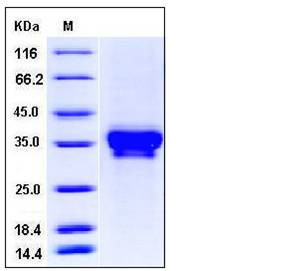Human STIM1 / GOK Protein (His Tag)
D11S4896E,GOK,IMD10,STRMK,TAM,TAM1
- 100ug (NPP4291) Please inquiry
| Catalog Number | P11434-H08H |
|---|---|
| Organism Species | Human |
| Host | Human Cells |
| Synonyms | D11S4896E,GOK,IMD10,STRMK,TAM,TAM1 |
| Molecular Weight | The recombinant human STIM1 consists of 202 amino acids and predictes a molecular mass of 23.3 kDa. In SDS-PAGE under reducing conditions, the apparent molecular mass of rh STIM1 is approximately 33-38 kDa due to glycosylation. |
| predicted N | Leu 23 |
| SDS-PAGE |  |
| Purity | > 97 % as determined by SDS-PAGE |
| Protein Construction | A DNA sequence encoding the human STIM1 (NP_003147.2) extracellular domain (Met 1-Asp 213) was expressed, with a polyhistidine tag at the C-terminus. |
| Bio-activity | |
| Research Area | Signaling |Signal Transduction |Signaling Pathway |Calcium Signaling |Calcium Binding Protein |Other Calcium Binding Proteins | |
| Formulation | Lyophilized from sterile PBS, pH 7.4 1. Normally 5 % - 8 % trehalose and mannitol are added as protectants before lyophilization. Specific concentrations are included in the hardcopy of COA. |
| Background | Stromal interaction molecule 1, also known as STIM1 and GOK, is a cell membrane, a single-pass type I membrane protein and a endoplasmic reticulum membrane protein. STIM1 / GOK is ubiquitously expressed in various human primary cells and tumor cell lines. It contains one EF-hand domain and one SAM (sterile alpha motif) domain. STIM1 / GOK plays a role in mediating Ca2+ influx following depletion of intracellular Ca2+ stores. It acts as Ca2+ sensor in the endoplasmic reticulum via its EF-hand domain. Upon Ca2+ depletion, STIM1 / GOK translocates from the endoplasmic reticulum to the plasma membrane where it activates the Ca2+ release-activated Ca2+ (CRAC) channel subunit, TMEM142A / ORAI1. Transfection of STIM1 / GOK into cells derived from a rhabdoid tumor and from a rhabdomyosarcoma that do not express detectable levels of STIM1 can induce cell death, suggesting a possible role in the control of rhabdomyosarcomas and rhabdoid tumors. Defects in STIM1 are the cause of immune dysfunction with T-cell inactivation due to calcium entry defect type 2 (IDTICED2) which is an immune disorder characterized by recurrent infections, impaired T-cell activation and proliferative response, decreased T-cell production of cytokines, lymphadenopathy, and normal lymphocytes counts and serum immunoglobulin levels. |
| Reference |
